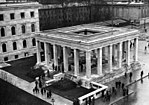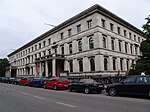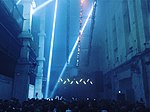The Sturmabteilung (German: [ˈʃtʊʁmʔapˌtaɪlʊŋ] ; SA; literally "Storm Division" or Storm Troopers) was the original paramilitary wing of the Nazi Party. It played a significant role in Adolf Hitler's rise to power in the 1920s and 1930s. Its primary purposes were providing protection for Nazi rallies and assemblies, disrupting the meetings of opposing parties, fighting against the paramilitary units of the opposing parties, especially the Roter Frontkämpferbund of the Communist Party of Germany (KPD) and the Reichsbanner Schwarz-Rot-Gold of the Social Democratic Party of Germany (SPD), and intimidating Romani, trade unionists, and especially Jews.
The SA were colloquially called Brownshirts (Braunhemden) because of the colour of their uniform's shirts, similar to Benito Mussolini's blackshirts. The official uniform of the SA was a brown shirt with a brown tie. The color came about because a large shipment of Lettow-shirts, originally intended for the German colonial troops in Germany's former East Africa colony, was purchased in 1921 by Gerhard Roßbach for use by his Freikorps paramilitary unit. They were later used for his Schill Youth organization in Salzburg, and in 1924 were adopted by the Schill Youth in Germany. The "Schill Sportversand" then became the main supplier for the SA's brown shirts. The SA developed pseudo-military titles for its members, with ranks that were later adopted by several other Nazi Party groups.
Following Adolf Hitler's rise to Nazi Party leadership in 1921, he formalized the party's militant supporters into the SA as a group that was to protect party gatherings. In 1923, owing to his growing distrust of the SA, Adolf Hitler ordered the creation of a bodyguard unit, which was ultimately abolished after the failed Beer Hall Putsch later that year. Not long after Hitler's release from prison, he ordered the creation of another bodyguard unit in 1925 that ultimately became the Schutzstaffel (SS). During the Night of the Long Knives (die Nacht der langen Messer) in 1934, the SA's then-leader Ernst Röhm was arrested and executed. The SA continued to exist but lost almost all its influence and was effectively superseded by the SS, which took part in the purge. The SA remained in existence until after Nazi Germany's final capitulation to the Allies in 1945, after which it was disbanded and outlawed by the Allied Control Council.











